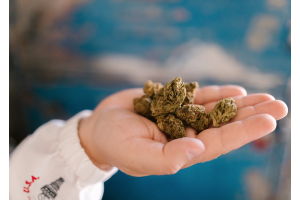Has THC Potency Changed Over the Years?

The most common reason to consume cannabis is its psychoactive effects. Cannabis is wildly used worldwide for recreational purposes, even though people have become more aware of its medical benefits in recent years.
Therefore, average adult-use cannabis consumers pay significant attention to the potency of delta-9 tetrachydrocannabinol, most commonly know as THC, the main cannabis compound that makes you feel high.
Although many experts and cannabis connoisseurs explain that THC is not the only cannabinoid to take into consideration when choosing a cannabis product, as the presence of CBD, minor cannabinoids, terpenes, and other cannabis ingredients play a significant role in the consumption experience, most people focus primarily on THC potency, expressed as mg/g or as a percentage of mg per gram.Experts debate today's increase in the THC potency of illicit and legal cannabis.
Prohibitionists often use this argument to claim that cannabis shouldn't be legalized because THC potency has become stronger and potentially more harmful for people compared to cannabis consumed decades ago.To assess if such an argument is actual, it is necessary first to understand how to measure THC contained in cannabis.As there is no official industry standard for calculating THC potency, different producers and test labs may calculate it differently.
Let's start by saying that cannabis produces tetrahydrocannabinolic acid (THCA), a non-intoxicating cannabinoid that we convert into THC through a chemical process called decarboxylation. In other words, heating cannabis through combustion or using a vaporizer transforms THCA into THC.The impact of THC potency on our body also depends on the consumption method, such as vaping, smoking, or dabbing. To measure total THC, we need to multiply the percentage of THCA by 0.877, which is the ratio of the molecular mass (mm) of THC divided by that of THCA, and add the weight percentage of THC. It is worth noting that this formula is not the only one used to calculate the total level of THC, as there are some variations.1 We can also determine the THC potency of cannabis through lab tests by using several methods, such as chromatography used to assess cannabinoid concentration.However, comparing THC levels in the cannabis sold today with cannabis sold decades ago would be more challenging. Since 1972, the Potency Monitoring Program belonging to the U.S.
Department of Justice has tested the THC of cannabis samples provided by law enforcement.2The samples typically contained less than 3-4% THC, and the sample size was tiny. However, many samples were analyzed several months or longer after harvest, just in time that cannabis THC could likely turn into CBN, another cannabis compound with no intoxicating effects, tainting the THC potency's assessment.In the 1980s, the average THC level in cannabis was about 4%, while since the first half of the 1990s, the potency of the illicit cannabis plant has consistently increased.3A study published in 2016 found that THC potency increased from about 4% in 1995 to about 12% in 2014.4
Today, it is common to find cannabis containing a THC level of over 20%. But the increase in THC potency is not a phenomenon related to the U.S. Health Canada, the department responsible for Canada's health policy, says that THC potency in dried cannabis has increased from an average of 3% in the 1980s to around 15% today.5Several studies6 show how THC in cannabis has risen significantly over the years, highlighting that this phenomenon has likely happened almost everywhere in the world.However, there are several factors to consider when assessing whether THC potency has increased over the years. First, in the United States, most cannabis consumed between the 1960s and 1980s was imported from other countries, such as Southern America.
Its quality was likely different from today's as it was a mixture of leaves, stems, and a hodgepodge of materials that contained only a tiny amount of the flowers rich in THC.7This fact alone could justify why cannabis today has a higher percentage of THC. But it is not the only factor to take into consideration. Improper storage of cannabis samples destined to be used to measure THC potency may have altered the assessment. Today, cultivators, processors, dispensaries, and consumers observe strict requirements to store cannabis to prevent its deterioration and preserve quality. Even illicit traffickers tend to take care of cannabis like consumers today have high expectations of the products.
Therefore, comparing cannabis from the 1970s to the one sold today is challenging unless the samples being compared were processed and stored in the same way as cannabis.Furthermore, the phenomenon of genetically modified cannabis is giving prohibitionists a pretext to advocate against legalization.In recent years, news media outlets have been bringing into the news the so-called genetically modified (GMO) cannabis, able to modulate THC potency, highlighting the harmful effects of high THC on the human body. GMO cannabis strains are made from unnaturally shuffling genes between different organisms or species to create a new version of the strain in a way that does not occur naturally.
Theoretically, you could produce pesticide-resistant cannabis crops with faster growth, bigger yields, and flowers rich in THC.On the one hand, GMO cannabis could produce strains with a level of THC higher than 30%, potentially harming the human body and impacting the environment. But on the other hand, this new technology could help solve technical problems related to the cannabis-supply chain.
For instance, GMO cannabis crops could improve cultivation and allow us to create strains able to use the resources more efficiently, have a high resistance to pests and disease, and produce high quantities of minor cannabinoids. However, this technology is still in its infancy, and industry players have an ongoing debate over its ethics. However, some companies have already developed strains that produce cannabis flowers with a higher level of THC.
Written and Published by Dario Sabaghi in Weed World Magazine issue 161
Featured Image: Pexels












Validate your login